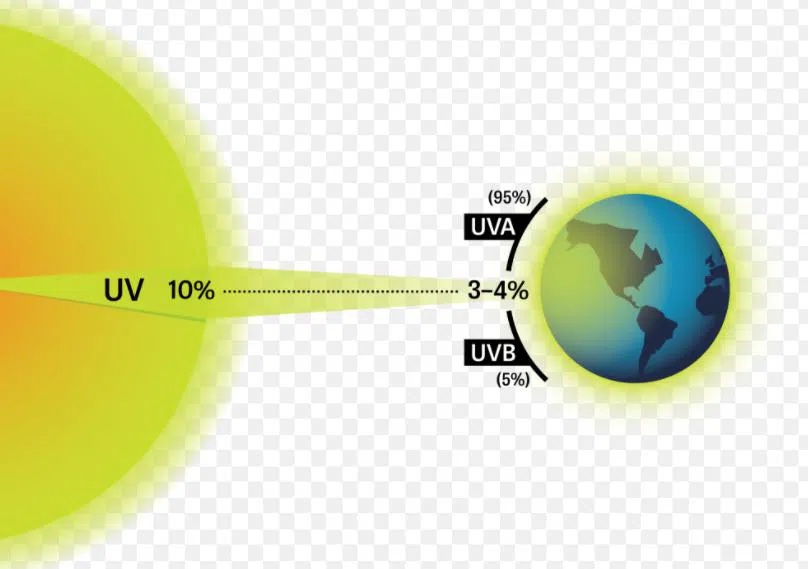English 


Views: 0 Author: Site Editor Publish Time: 2021-01-29 Origin: Site
The earth’s atmosphere prevents most of the sun’s ultraviolet radiation from penetrating the atmosphere. Passing in a small amount has both positive and negative effects.

The positive (beneficial) effects of UV
Trigger Vitamin D-Ultraviolet rays from the sun are required by our body to produce vitamin D. Vitamin D helps strengthen bones, muscles and the body's immune system. It may also reduce the risk of certain cancers, such as colon cancer.
Helps certain skin conditions-UV rays are used to treat skin conditions such as psoriasis. This is when the skin sheds its cells too quickly and forms itchy, scaly patches. Exposure to ultraviolet rays slows the growth of skin cells and relieves symptoms.
Help improve mood-research shows that sunlight can stimulate the pineal gland of the brain to produce certain chemicals called "tryptamine." These chemicals can improve our mood.
Help the sight of certain animals-some animals (including birds, bees and reptiles) can see near-ultraviolet light and find many ripe fruits, flowers and seeds that stand out in the background. Fruits, flowers and seeds usually look completely different from what humans see. For example, when viewed under ultraviolet light, some flowers have different line markings, which may help guide bees and birds to nectar.
Help certain insects navigate-many insects use the ultraviolet radiation of celestial bodies as a reference for flight navigation. This is why lights sometimes attract flying insects by disrupting the flight process.
Can be used for disinfection and sterilization-UV has active applications in the field of disinfection and sterilization. For example, when diapers, underwear and tea towels are hung on the clothesline, ultraviolet rays can effectively "kill" (inactivate or destroy) microorganisms such as viruses and bacteria. In order to destroy microorganisms, ultraviolet rays penetrate cell membranes and damage DNA, thereby stopping their ability to multiply and reproduce. This destructive effect explains why we can use ultraviolet antibacterial lamps for disinfection and sterilization. The Mangere wastewater treatment plant in Auckland usesUVC lamps to disinfect wastewater.
Negative (harmful) effects of UV
Causes skin cancer-ultraviolet light is an environmental human carcinogen. It is the most prominent and common carcinogen in our environment. There is very strong evidence that each of the three main types of skin cancer (basal cell carcinoma, squamous cell carcinoma, and melanoma) are caused by sun exposure. Studies have shown that up to 90% of skin cancers are due to ultraviolet radiation.
Causes sunburn-UV rays can burn the skin. Sunburn is a burn that occurs when skin cells are damaged. The damage to the skin is caused by the absorption of energy by ultraviolet rays. The excess blood flows to the damaged skin in an attempt to repair it, which is why the skin becomes red after sunburn.
Damage to the immune system-Excessive exposure to ultraviolet radiation can have a harmful inhibitory effect on the immune system. Scientists believe that sunburn can change the distribution and function of human white blood cells that fight disease within 24 hours of exposure to sunlight. Repeated overexposure to ultraviolet light can further damage the body's immune system. The immune system protects the human body from bacteria, microorganisms, viruses, toxins and parasites (disease and infection). You can understand the effectiveness of the immune system by observing how quickly something decays after death and how the immune system stops working.
Damage to the eyes-Prolonged exposure to ultraviolet light or high-intensity ultraviolet light (such as in a sunbed) can damage the tissues of the eyes and may cause "burns" on the surface of the eyes, called "snow blindness" or keratitis. This effect usually disappears within a few days, but it may further complicate life in the future. In 1998, the Journal of the American Medical Association reported that even with very little sunlight, it may increase the risk of eye damage, such as cataracts (which can cause blindness without treatment), pterygium and pinworms. The damage of ultraviolet rays to the eyes is cumulative, so it is never too late to start protecting the eyes.
Aging skin-UV rays will accelerate the aging of the skin, because UV rays will damage the collagen and connective tissue under the top layer of the skin. This can cause wrinkles, brown "liver" spots and loss of skin elasticity. The difference between the skin tone, wrinkles or pigmentation on the underside of a person's arm and the upper side of the same arm illustrates the effect of sunlight on the skin. Generally, the top of the arm is exposed to the sun more often and is more harmful to the sun. Since photoaging of the skin is cumulative, it is never too late for a person to start a sun protection program. Otherwise, although tan looks good now, you may have to pay for wrinkled leather or skin cancer in the future.
